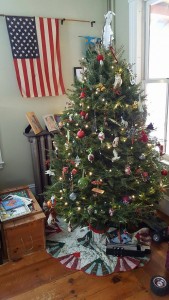LEDs burning brighter than ever this season
During the days after Christmas, after the toys, books and clothes are unwrapped and the turkey has been eaten, my family likes to cruise through nearby communities and gaze – well OK, pass judgment — on all the beautiful holiday lights.
Good one, my husband might exclaim.
Cool, my son will add.
Tacky, declares my daughter.
Oh look down there, that looks like a good street.
And so it goes, evaluating and just enjoying the displays of light that bring merriment to New England during the darkest days of winter.
Over the years we (or so we believe) have become connoisseurs of the ever more creative displays. In recent years, we keenly observe, displays have become what might technically be called a mish-mash.
Bright bluish white LEDs mixed with old fashion yellow lights. What the industry calls cold blue versus warm blue. And big C9 color bulbs mixed with soft little icicles. Beside all of these lights, a giant Snowman balloon alongside a munching incandescent deer.
Well, if it was bedlam out there, the good news is that we are slowly moving towards a much more efficient display of holiday cheer. And now, while the sales are on is the perfect time to get your LED holiday lights at an especially low cost.
Anecdotal evidence tells you that the ratio of LED bulbs to energy guzzling incandescent lights has gone up significantly. The cause may be greater energy consciousness. Or that the price of LED has dropped enough to draw in consumers. Or as I will argue, it’s because the elves created a more appealing LED light in the warm spectrum, slightly closer to the yellow whites we are used to.
In fact, our backseat analysis of the trend turns out to be true.
According to the Department of Energy, holiday light strands are becoming ever more popular. They’re sturdier, last longer and consume 70 percent less energy than conventional incandescent light strands. It only costs 27 cents to light a 6-foot tree for 12 hours a day for 40 days with LEDs compared to $10 for incandescent lights. For those who aren’t mathematicians, that’s a big difference.
Lighting today is safer and brighter than ever. The history of lighting began with candles, pretty but not so safe. Incandescent lights were a step up, and now we have LEDs, which are cooler to the touch and much safer. Plus, they are significantly less likely to burn out or break. LEDs are sturdier because they are made with epoxy lenses instead of glass, so break less easily. Also, as many as 25 strings of LEDs can be connected together without overloading an electrical outlet.”
We know LED holiday lights cost more up-front, but they save a lot of money in the long run. Besides using less energy, they last 25 times longer. I know, because for the first time, I haven’t had to replace my little strand of outdoor lights for two years.
DOE estimates the cost of buying and operating lights for 10 holiday seasons is:
- Incandescent C-9 lights, $122.19
- LED C-9 lights, $17.99
- Incandescent mini-lights, $55.62
- LED mini-lights, $33.29
OK, so the warm LEDs aren’t quite as cozy as the old white lights, but they are close. Anyway, I’ve come to see those cool blue ones as cleaner, more wintry. I can even envision a time when the yellow ones will seem dirty. And, to my family, they already are feeling unnecessarily wasteful and expensive.
For 2017, resolve to get LEDs. And I hope you enjoy the light shows as much as I do.
Amy Miller works in the Office of Public Affairs at EPA New England.
Fore more information on LEDs: https://www.energy.gov/energysaver/led-lighting

